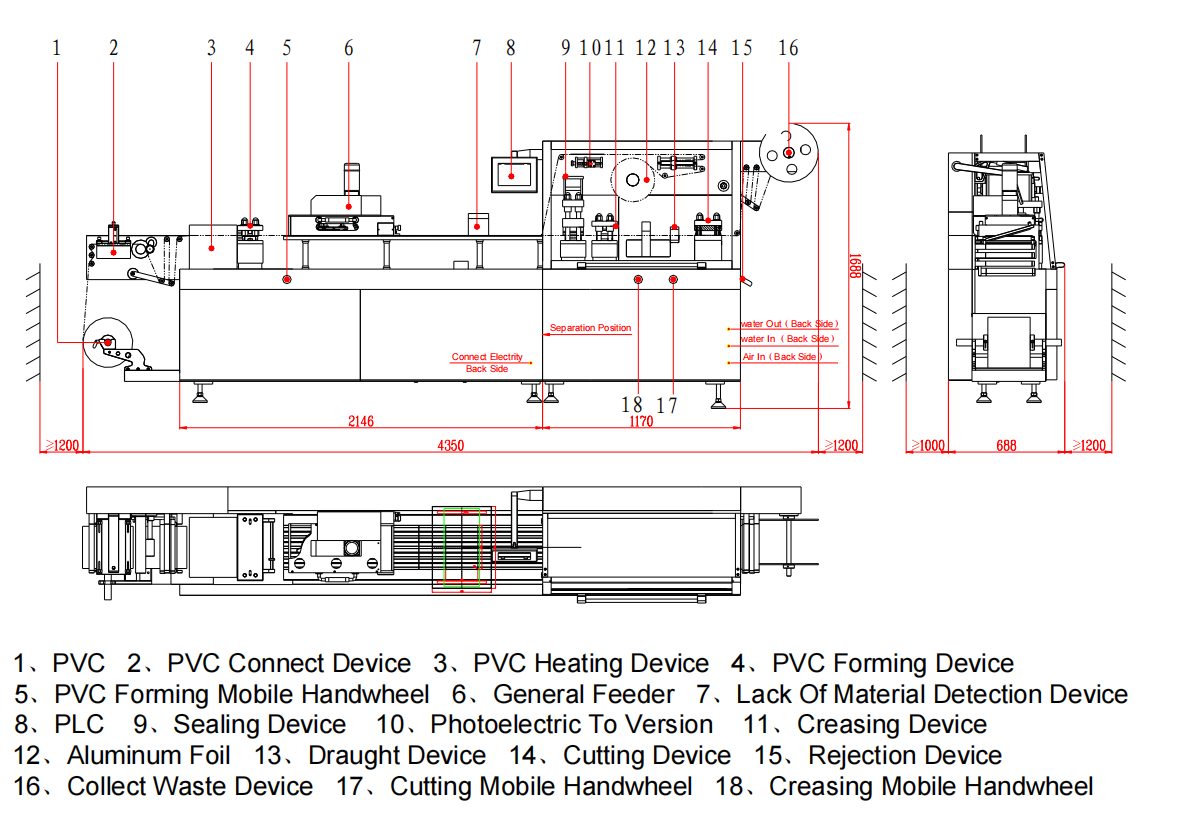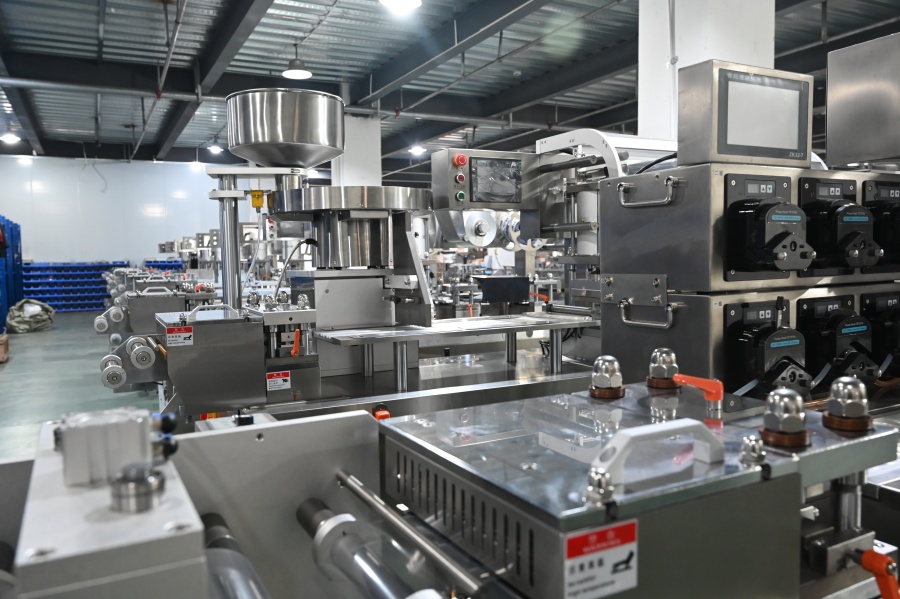Tablet manufacturing isn’t just about mixing powders and pressing them into shape. Behind every pill on a pharmacy shelf is a precision-built process powered by tablet manufacturing equipment.
From tablet compression machines that press each dose with pinpoint accuracy to blenders, coating, and packaging systems that protect the final product. Every machine plays a crucial role.
And in this guide, you’ll see exactly what each one does, how it works, and why it matters.
What is the Process of Tablet Manufacturing?
The tablet manufacturing process transforms powders and granules into compact, uniform tablets. It begins with formulation, where Active Pharmaceutical Ingredients (APIs) and excipients are carefully selected, measured, and optimized for performance.
The prepared materials then undergo granulation, either dry or wet, to improve flow and compressibility. This is followed by compression, where the granules are pressed into tablets with their distinct size and shape. Coating is applied next to enhance appearance, mask taste, protect the active ingredient, and control drug release.
After production, each batch undergoes rigorous quality control, including tests for drug content uniformity, weight variation, dissolution, and disintegration time, as well as hardness and friability to ensure durability during handling. Finally, the tablets are packaged in protective formats to preserve stability during storage, transport, and distribution.
10 Important Tablet Manufacturing Equipment List and their Applications
Producing compact, precisely dosed tablets isn’t just about following a formula; it’s about using the right tools for the job. Each piece of tablet manufacturing equipment has a specific role, from mixing and granulating to compressing, coating, and packaging. When these machines work together, they create a streamlined process that delivers consistent quality at scale.
Here are 10 of the most important tablet manufacturing equipment, and exactly what they do.
1. Tablet Compression Machine
The tablet compression machine, often called a tablet press, is one of the most essential components in production. It compresses granules into tablets using the upper and lower punches that meet within the die station.

There are two main types: single-punch press, suitable for small-scale production, and rotary press machines, designed for high-scale production.
Applications
- Producing prescription tablets with precise dosage.
- Manufacturing over-the-counter tablets such as pain relievers and antacids.
- Creating vitamin and mineral supplement tablets.
2. Double Cone Blender
It gently mixes APIs and excipients to create a uniform blend. Achieving consistent mixing is essential to avoid variability in the active ingredient concentration across tablets. This consistency makes sure consumers receive the correct dosages for their medication and supplements.

Applications
- Dry blending of powders for pharmaceutical and nutraceutical blends.
- Handling large volumes of ingredients for higher yield within a short production cycle.
- Processing minerals by controlling the blend speed and time.
3. Rapid Mixer Granulator
The rapid mixer granulator performs wet granulation by mixing powders with a binder solution to form granules. Granulation improves the flow and compressibility of powders, which is crucial for tablet manufacturing. Using a rapid mixer granulator reduces weight variation during compression and prevents common issues, such as capsules sticking to punches.

Applications
- Helping with common tablet defects, such as capping, lamination, and uneven active content distribution.
- Preparing granules for moisture-sensitive medications using controlled binder addition.
- Forming homogenous granules for high-dose drug formulations.
4. Fluid Bed Dryer
As the name suggests, a fluid bed dryer dries the wet granules uniformly. It suspends granules in warm air for fast, consistent drying at a controlled temperature. Compared to oven drying, fluid bed drying can cut down the drying time by more than 5 hours. As a result, the energy consumption decreases by 35.8%.

Applications
- Providing a cost-effective solution for drying moisture-sensitive APIs.
- Drying herbal powders and protein blends for manufacturing nutraceutical tablets.
- Manufacturing of fruit and vegetable powders in tablet form.
5. Multi Mill or Disc Mill
After drying, granules pass through a multi-mill or disc mill equipment, which reduces their size and breaks up any clumps. Milling produces a consistent granule size, which helps to achieve a uniform tablet size and density.

Applications
- Milling of plant-based ingredients for nutraceutical blends.
- Size reduction of excipients for controlled-release formulations.
- Preparing fine powders to prevent blockage during tablet compression.
6. Vacuum Conveyor
A vacuum conveyor automates the transfer of powders and granules between processing stations without manual handling. This lowers the contamination risk and makes the manufacturing process more efficient. Other types of conveyor systems, including the belt, roller, and modular conveyors, are also used in the pharmaceutical industry.

Applications
- Careful handling of powders safely in closed systems.
- Moving granules to different production areas without manual lifting.
- Feeding packaging lines directly from the production or storage.
7. Vibro Sifter or Vibration Mill
Before compression, powders are screened using a vibro sifter or vibration mill. This removes oversized particles and ensures granules are consistent in size. The equipment consists of a compression container with a tube, supported by several springs and powered by a motor. Constant vibrations separate and break down oversized particles.

Applications
- Removing lumps and foreign materials during API handling.
- Screening of raw materials before production.
- Grading granules for uniform, high-quality pharmaceutical tablets.
8. Lifting, Turning, and Tilting Device
This device supports operators in handling heavy containers, bins, and trays of raw materials. These handling machines reduce manual lifting risks and speed up the production process. The hydraulic cylinder and automatic positioning help with the lifting, while the tilting is done by the worm gear reducer. Moreover, the machine body can be manually rotated to 90°, which makes labor-intensive tasks easier.

Applications
- Loading heavy granule bins into the tablet compression machines.
- Assisting in the cleaning and maintenance of large mixing vessels.
- Connects to the granulator for automatic discharge without manual labor.
9. Automatic Tablet Coater
Automatic tablet coaters are used to apply a uniform layer of film, enteric, sugar, electrostatic, or dip coatings. These coatings mask unpleasant taste, control drug release, and protect the tablets from moisture and oxygen exposure.

Applications
- Extending the shelf-life and stability of light and moisture-sensitive drugs.
- Helping with product identification and branding.
- Manufacturing delayed-release tablets.
10. Packaging Machines
The packaging industry is a vital part of the pharmaceutical manufacturing process. Its significance is reflected in projections estimating its value to reach USD 153.9 billion by 2035.

In pharmaceuticals, common packaging types include blister, strip, and aluminium foil packaging. These methods protect tablets during transport and storage, aid in traceability, and support regulatory compliance.
Applications
- Creating tamper-evident seals for OTC medications.
- Packaging unit-dose tablets for hospitals and clinics.
- Designing protective packaging against moisture, oxygen, and contamination.
The Undeniable Importance of Tablet Manufacturing Equipment
Each tablet manufacturing equipment plays a crucial role in determining the accuracy, stability, and compliance of the finished product. From the initial blending to the final packaging of the finished products, these machines are designed to ensure production is efficient and compliant. They also maintain a high level of accuracy, so that each batch meets the required quality standards.
By combining high-quality machinery with automation and real-time monitoring, manufacturers can reduce human errors and speed up the process. This approach supports compliance with GMP and FDA regulations.
FAQs
What is the manufacturing process of tablets?
The tablet manufacturing process involves formulation, granulation, compression, coating, quality control, and packaging. Each stage requires specialized equipment to ensure consistent quality, regulatory compliance, and scalability of the production line.
What are the different types of tablet press machines?
There are several types of tablet press machines available in the market. These include:
- Single-Punch Tablet Press: Uses a one-punch and dye set, ideal for small-scale production. It is capable of producing 3000 tablets per hour.
- Rotary Tablet Press: Equipped with multiple punches and dies mounted on a rotating turret, capable of producing between 100,000 and 170,000 tablets per hour.
- Multi-layer Tablet Press: Produces tablets with multiple layers containing different active ingredients.
- High-Speed Tablet Press: Designed for mass production with ultra-high speed. It gives an even higher output than rotary tablet press machines.
- Hydraulic Tablet Press: Applies compression pressure through liquids for tablets with specific hardness or density needs.
What is meant by the coating of a tablet?
The coating is a protective layer on the tablet’s surface. This coating masks the unpleasant color, taste, or appearance of the tablet and controls drug release. It also protects the drug from the acidic environment of the stomach and improves its stability. The tablet may have sugar, film, electrostatic, enteric, vacuum, or dip coating on its surface.



